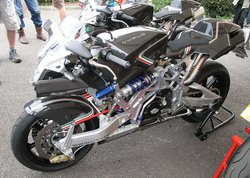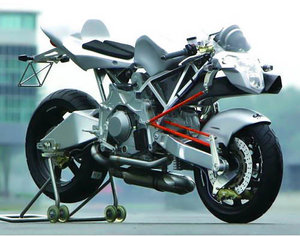Vyrus
Vyrus is an exclusivist Italian motorcycle manufacturer based in Rimini, Italy. Vyrus initially worked alongside Bimota on the development of the Tesi motorcycle and its Hub-center steering centre. They split from the firm and finished the development, marketing the bike as their own.
Currently they have two models: 984 C3 2V and 985 C3 4V, both with a displacement of almost 1000 cm³. The 984 has a V-twin 2 valve Ducati engine which develops a claimed 90.5 HP. The 985 has V-twin 4 valve Ducati engine which develops a claimed 150 HP.
The engineers of the company are experienced in high-class motorcycles: many of them worked for companies like Ducati or Bimota.
2006 Vyrus 985: From Tesi to Vyrus--and Back Again
The making of the most high-tech sport bike on the market
Writer: Alan Cathcart
Rimini-born Vyrus virtuoso Ascanio Rodorigo has lived and worked all his life in the motorcycling hotbed of the Riviera Adriatica, beginning as a 20-year old wrench for the local Bimota factory race team in 1973 under the aegis of his idol, Massimo Tamburini. After Tamburini's departure, Bimota suffered one of its periodic financial crises and stopped racing, although Tamburini's replacement, Federico Martini, soon righted matters commercially by creating the firm's best-selling debut Ducati-powered bike, the DB1. After a spell on the production line building customer bikes, Rodorigo was, ironically, long gone by the time Martini built the first-ever Honda V4-powered Tesi prototype in 1985, a hub-center design which was the Mech.E thesis (hence the name) of his young assistant fresh out of university, Pierluigi Marconi.
"I learned a lot building customer bikes for Bimota, but it was so repetitive I had to leave before I got bored," admits Rodorigo, who on January 1, 1985 opened his own company under the ARP name on the other side of Rimini, a small but soon well-regarded workshop producing special parts for race or road, as well as a variety of special sportbike frames. "My passion has always been to build prototypes and one-off concepts," says the machine-room Picasso, who also became recognized as the man to visit if you had an unusual bike, and especially a racer, that needed work done. "Our team at ARP was very adaptable and could work very fast in making one-off parts or complete bikes. We were like a mouse compared to the elephant that bigger companies' development departments were, by comparison. I worked on quite a few Tesis, and we were always having problems with them which seemed impossible to resolve. But I had an Australian friend, Matthew Casey, who worked for Bimota in the 1990s, and he has four of them! He was always telling me to make a Tesi the way I wanted to-`It's your kind of motorcycle-just go and do it!' he kept telling me. So, eventually, in September 2002, I decided to do so."
ARP already had some pretty effective after-hours helpers, not least Dervis Macrelli, the frame-making wizard who's worked with Tamburini putting his ideas into metal ever since the early Bimota days, and who got into the habit of stopping by ARP after clocking off at CRC (Cagiva Research Center) to help create what became known as the Vyrus. Where'd that somewhat, er, negative-sounding name come from, then? "When considering how the first prototype should be, we decided to build a bike to display at the Padova Show the following January, which is the Mecca for anyone doing something special on two wheels in Italy," explains Rodorigo. "It was a real challenge that meant we worked day and night for three months. One night at 3 a.m., I was washing my hands free of powder after working on the body styling-we didn't have 3D computer modeling, we did everything by hand according to a rough drawing, just by eye. My friend Mauro working with me was a builder during the day, and he kept trying to persuade me to go to bed-so he could too, I guess! But I wanted to get the body finished-then when we'd done so I suddenly realized we hadn't got a name for the bike. We couldn't call it Tesi, because that was Bimota's name-but then Mauro told me, we must call it Vyrus, but with a `y' not an `i', because this is not like the one before, a virus that is in every computer and maybe in us, too, to be so crazy working here at 3 a.m. to build a motorcycle. So, that's when ARP became Vyrus."
That first Vyrus 984 duly made its debut at the Padova Show in January 2003, powered by a tuned Ducati 900SS desmodue motor of the kind ARP had been racing with success in SuperTwins events-hence the model designation, which was the cubic capacity of the engine. "We knew this engine very well from racing it, so it had no secrets from us," states Rodorigo. "If we were to concentrate on trying to make this high-tech chassis design work properly, we had to not worry at all about the engine, so that's why we chose the desmodue. It was a known quantity." But the proprietor of the new Vyrus company admits to being completely unprepared for the rapturous reception his new bike received. "We had literally hundreds of inquiries to make production versions of our prototype, which we were quite unprepared to do," he says. "But I realized we had now to turn the prototype into a customer version we could manufacture in series in small batches, always by hand, but in some kind of volume. We had to get the bike homologated first, though, which in fact was a fascinating experience I enjoyed very much, producing the lightest twin-cylinder sportbike in the marketplace, though always completely street-legal-but finally we succeeded."
After an intensive development process on the racetrack, during which the Vyrus 984 Pro Twins racer became a regular visitor to the rostrum in European twin-cylinder racing in the hands of Gianluca Villa, nephew of the late four-time world champion Walter, the first fully homologated Vyrus streetbike met its happy customer in January 2003. Since then, a total of 70 such bikes have been constructed, 25 of them marketed in a neat squaring of the circle under the Tesi 2D tag by the born-again Bimota company through their dealers around the world-including two bikes sold in Russia, and 10 to Japan. With production up and running of this desmodue version, delivering 77 bhp in a bike weighing 339 pounds in street-legal form, Rodorigo turned his attention to a Superbike version powered by Ducati's 104mm-bore 999cc Testastretta motor, to create a modern version of the original Tesi which inspired the whole design. After a strung-out development path beginning back in 2004 ("We are only five people, and demand for the 984 is so constant, we couldn't spare the time to pay attention to the new bike," he shrugs), the first 985 appeared at the start of this year, and was promptly sold-to Russia! Since then, two more 4V bikes have been built, of which the test machine was the first Vyrus to cross the Atlantic to head up a U.S. sales drive.
The dramatic modernist styling of the Vyrus 985 is the work of Rodorigo himself, with close help from ex-Ducati designer Sam Matthews, formerly Pierre Terblanche's right-hand man, but now working for Citroen in Paris. "We did this at long distance, with Sam making CAD drawings and me interpreting them into a full-size clay model, then e-mailing him photos of the result," says Rodorigo. A copy of the finished article can be yours in the color of your choice 60 days after placing an order for 54,750 Euro (about $67,750) inclusive of tax in Italy, with full EU homologation. A fully-faired option will be available later this year, at additional cost. Source
External links
Send what you have to:
| Motorcycle Information and Photos by Marque: A - B - C - D - E - F - G - H - I - J - K - L - M - N - O - P - Q - R - S - T - U - V - W - X - Y - Z |
| Car Information and Photos by Marque: A - B - C - D - E - F - G - H - I - J - K - L - M - N - O - P - Q - R - S - T - U - V - W - X - Y - Z |


